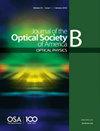超强和深强耦合系统松弛过程的自洽描述
IF 1.9
4区 物理与天体物理
Q3 OPTICS
Journal of The Optical Society of America B-optical Physics
Pub Date : 2023-10-03
DOI:10.1364/josab.501199
引用次数: 0
摘要
当子系统之间的耦合强度超过系统本征频率的十分之一时,复合系统就会出现超强耦合状态。当耦合强度超过系统特征频率时,系统进入深强耦合状态。在这些制度中,如果不明确考虑环境自由度,就难以描述松弛过程。为了正确地评估弛豫率,有必要考虑系统与环境的相互作用,同时考虑反旋转波和反磁项。我们提出了一种计算系统弛豫率的自洽理论,其中耦合强度是系统本征频率的阶。我们证明了耦合强度的增加可以导致弛豫速率的显著降低。特别是,我们表明,对于与频率无关的环境态密度,弛豫率随着耦合强度的增加呈指数下降。这一事实可用于通过调整强度耦合和环境状态来抑制损耗。本文章由计算机程序翻译,如有差异,请以英文原文为准。
Self-consistent description of relaxation processes in systems with ultra- and deep-strong coupling
An ultra-strong coupling regime takes place in a compound system when a coupling strength between the subsystems exceeds one-tenth of the system eigenfrequency. It transforms into a deep-strong coupling regime when the coupling strength exceeds the system eigenfrequency. In these regimes, there are difficulties with the description of relaxation processes without explicit consideration of environmental degrees of freedom. To correctly evaluate the relaxation rates, it is necessary to consider the interaction of the system with its environment taking into account the counter-rotating wave and diamagnetic terms. We develop a self-consistent theory for the calculation of the relaxation rates in the systems, in which the coupling strength is of the order of the system eigenfrequency. We demonstrate that the increase in the coupling strength can lead to a significant decrease in the relaxation rates. In particular, we show that, for frequency-independent density of states of the environment, the relaxation rates decrease exponentially with the increase in the coupling strength. This fact can be used to suppress losses by tuning the strength coupling and the environment states.
求助全文
通过发布文献求助,成功后即可免费获取论文全文。
去求助
来源期刊
CiteScore
4.00
自引率
5.30%
发文量
374
审稿时长
2.1 months
期刊介绍:
The Journal of the Optical Society of America B (JOSA B) is a general optics research journal that complements JOSA A. It emphasizes scientific research on the fundamentals of the interaction of light with matter such as quantum optics, nonlinear optics, and laser physics. Topics include:
Advanced Instrumentation and Measurements
Fiber Optics and Fiber Lasers
Lasers and Other Light Sources from THz to XUV
Light-Induced Phenomena
Nonlinear and High Field Optics
Optical Materials
Optics Modes and Structured Light
Optomechanics
Metamaterials
Nanomaterials
Photonics and Semiconductor Optics
Physical Optics
Plasmonics
Quantum Optics and Entanglement
Quantum Key Distribution
Spectroscopy and Atomic or Molecular Optics
Superresolution and Advanced Imaging
Surface Optics
Ultrafast Optical Phenomena
Wave Guiding and Optical Confinement
JOSA B considers original research articles, feature issue contributions, invited reviews and tutorials, and comments on published articles.

 求助内容:
求助内容: 应助结果提醒方式:
应助结果提醒方式:


